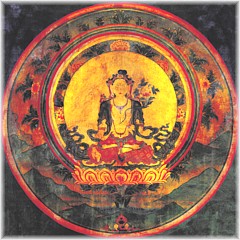White Tara: Difference between revisions
Jump to navigation
Jump to search
No edit summary |
No edit summary |
||
| (2 intermediate revisions by one other user not shown) | |||
| Line 1: | Line 1: | ||
[[Image:JKW Tara med2.jpg|frame|The sacred image of White Tara, 'The Wish-Fulfilling Wheel' found in the empowerment room of [[Jamyang Khyentse Wangpo]]'s residence, [[ | [[Image:JKW Tara med2.jpg|frame|The sacred image of White Tara, 'The Wish-Fulfilling Wheel' found in the empowerment room of [[Jamyang Khyentse Wangpo]]'s residence, The [[Garden of Immortality]]]] | ||
'''White Tara''' (Skt. Sitatārā; Tib. སྒྲོལ་དཀར་, ''Drolkar'' | '''White Tara''' (Skt. ''Sitatārā''; Tib. སྒྲོལ་དཀར་, ''Drolkar'', [[Wyl.]] ''sgrol dkar'') — manifestations of [[Tara]], white in colour, associated with [[long life practice]]s. The most well known is [[White Tara Wishfulfilling Wheel]] which is the main deity of the [[Chimé Pakmé Nyingtik]] [[sadhana]] for example. | ||
==Further Reading== | |||
*[[Ringu Tulku Rinpoche]], ''White Tara – Healing Light of Wisdom'' (Bodhicharya, 2022) | |||
==External Links== | ==External Links== | ||
Latest revision as of 12:09, 22 June 2023

White Tara (Skt. Sitatārā; Tib. སྒྲོལ་དཀར་, Drolkar, Wyl. sgrol dkar) — manifestations of Tara, white in colour, associated with long life practices. The most well known is White Tara Wishfulfilling Wheel which is the main deity of the Chimé Pakmé Nyingtik sadhana for example.
Further Reading
- Ringu Tulku Rinpoche, White Tara – Healing Light of Wisdom (Bodhicharya, 2022)